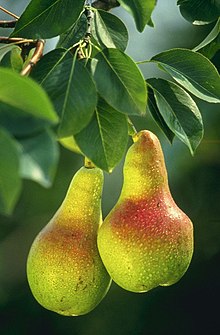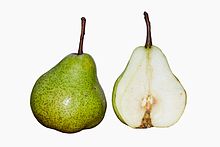
Back Peer Afrikaans Birnen ALS ሸክኒት Amharic Pyrus AN كمثرى (جنس) Arabic ܟܡܬܪܐ ARC كمثرى (جنس نباتى) ARZ Pyrus AST Wamin ka kinkomakisitc ATJ Гени AV
| Pear | |
|---|---|

| |
| European pear branch with two pears | |

| |
| Pear fruit cross section | |
| Scientific classification | |
| Kingdom: | Plantae |
| Clade: | Tracheophytes |
| Clade: | Angiosperms |
| Clade: | Eudicots |
| Clade: | Rosids |
| Order: | Rosales |
| Family: | Rosaceae |
| Subfamily: | Amygdaloideae |
| Tribe: | Maleae |
| Subtribe: | Malinae |
| Genus: | Pyrus L. |
| Species | |
|
About 30 species; see text | |
The term pear may refer to a number of fruits produced and consumed around the world, growing on a tree and harvested in the Northern Hemisphere in late summer into October. Its shape is a teardrop, the flavor of pears is best when they are cool. They are juicy. Pears do not ripen well on trees. They can be soft in the center. They can be baked, canned, frozen, or eaten fresh. They can be made into jams, jellies or juice. They can also be made into pies and put into salads or baby food. They are eighty three percent water. It has a green, red, yellow, or brown skin. The pear originated from Europe, Africa and Asia. Pear trees grow in heavy soil.
Pears are in the subfamily Maloideae with apples. It is a subfamily of the family Rosaceae.